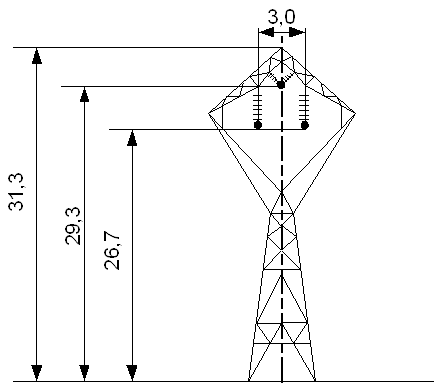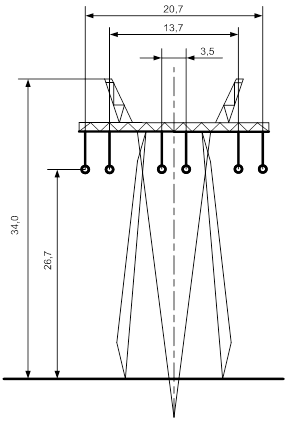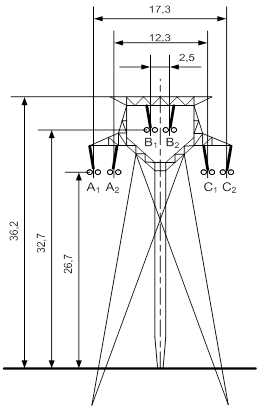Abstract
Сontent
- Introduction
- Currency of the theme
- The purpose of the work
- The idea of work
- The main tasks of research and development
- The scientific novelty
- Practical application
- A review of research on the topic In DonNTU
- A review of research on the topic in Ukraine
- A review of research on the topic in the world
- The main content of work
- CAD system using
- Classification of a new generation of overhead lines
- Specifications of the most representative variants TL–220 kV new generation
- Means of control for the overhead of a new generation
- Conclusion
- References
Introduction
To date, the relevance of using computer-aided design (hereafter CAD) is an important task for organizations that are involved in the design of overhead transmission lines (hereafter TL). Since automation is the best solution for your computer, then this task much easier. For the calculations corresponds to an application that is designed for this type of calculations, and the uniqueness of the designed object, or select one of the options for implementing the project meets the designer himself.
Therefore, the use of CAD is a relevant and cost-effective solution that will reduce costs for overhead projection.
Currency of the theme
The scientific importance due to the creation of a universal algorithm (CAD) software, which enables design overhead of any complexity using different kind of wires and FACTS
The practical relevance of the implementation of the developed CAD design organizations that deal with issues such as design or reconstruction of the TL.
The purpose of the work
Development and study of educational research CAD of the overhead transmission lines, based on the wiring new construction.
The idea of work
The initial data for the work are graduate achievements DonNTU A. Alagulovoy, M. Hvorostyanenko, M. Kurova [1],[2],[3], which are involved in the improvement of algorithms and subsystems CAD overhead, as well as working professionals V. Postolati, E. Bykova, J. Shakarian methodical approaches to the selection of variants of a new generation of transmission lines [4].
Thus, the above design can be used to create computational algorithms to design a new generation of overhead lines.
The main tasks of research and development
With the use of specified kind of wires you must create an algorithm for CAD.
The scientific novelty
Is to develop an algorithm for the design of distribution networks FACTS
Practical application
The scope of the MI CAD overhead in the design of electrical networks
A review of research on the topic In DonNTU
There is today a suite of applications CAD overhead in our university. At the department of electrical systems DonNTU developed two versions of CAD, which are successfully used in the scientific process over the past 30 years: one - the use of OS DOS, the other - OS WINDOWS XP. In 2010, Hvorostyanenko M. and Alagulovoy A. developed [1],[2], a new software suite CAD taking into account existing in Ukraine, RB: 2006[7].
A review of research on the topic in Ukraine
Today there are several successful software products that are implemented in CAD software, as they try to implement for use in design organizations.
A review of research on the topic in the world
Successful implementation of the CAD software package development EnergyCS Line [5] (Russia). It is designed to automate the process of designing a mechanical part of the TL, fiber-optic cables, fiber-optic communication lines, flexible oshinovok open distribution devices. This complex includes the previously obtained estimates for the design of objects, as well as databases of background information on the wires, cables, supports VL, isolators, climatic regions of Russia.
The main content of work
CAD system using
CAD [6]consists of technical and documentation systems: Technical system contains a linear, construction and installation of the subsystem.
In the linear subsystem run these types of calculations:
- calculation of the mechanical strength of the wires;
- placement of poles on the longitudinal profile of FACTS;
- calculation of the intersection of engineering structures, artificial barriers.
In the construction and assembly subsystem, the following procedures:
- load calculation and choice of foundation supports of FACTS ;
- choice of foundation or typical bearing attachment for FACTS;
- calculation and selection of devices that support overhead grounding for FACTS;
- Defined by mounting arm sag of FACTS.
Documentary system consists of nine units, each of which comes from a separate calculation of the technical system, or your own document and contains the following reports:
- journal of placing towers of FACTS;
- statement of intersections with FACTS;
- the drawing of the longitudinal profile of FACTS;
- drawing intersections witch FACTS;
- statement of supports and foundations of FACTS;
- statement of devices that support overhead grounding for FACTS;
- statement of vibration dampers;
- statement insulator chains;
- the assembly table.
Classification of a new generation of overhead lines
The category of modern overhead lines in a present stage is classified as single-circuit overhead line and the multichain high compared to the overheads of the traditional type of capacity, equipped with modern control devices such as FACTS, meeting all pre-assigned technical and economic characteristics and operational parameters. These power lines are called managed flexible ac transmission lines (gypsum fiber board). For gypsum fiber board are:
- compact three-phase single circuit overhead lines (SCOL);
- compact multichain three-phase overhead line (MSOL);
- controlled double circuit overhead line and the multichain self compensatory (DCOL);
- combined controlled overhead, including the compact L (SCOL and / or MCOL) and DCOL.
Modern overhead lines has higher provision above all, compatibility in configurations, location of phase with the minimum allowable distance between them, the choice of the optimal design of linear phase and the splitting of isolation, the use of new types of supports that enable a compact design of the line with the minimum distances between phases and between phases to provide insulating elements established in the spans, structural stability of the line as a whole when exposed to adverse climatic factors.
Specifications of the most representative variants TL–220 kV new generation
Based on the analysis of domestic and foreign operations in the area of new developments, overhead lines (OL) 35-220 kW is the most selected option of the modern 220 kV. The constructional supports of these options are shown in Pic. 2-4. In Pic.2-4, three-phase single-circuit overhead line compact (OKVL) double circuit overhead line compact (DKVL) and double circuit overhead lines operated self compensation (DCOL) are shown, respectively . Reliance, as shown in Pic. 3, is applicable both for double-circuit overhead line compact, and for the two-chain DCOL.

Picture 2 – Three-phase single-circuit overhead line compact (OKVL)

Picture 3 – Double circuit overhead line compact (DKVL)

Picture 4 – Double circuit overhead lines operated self compensation (DCOL) are shown, respectively
Means of control for the overhead of a new generation
Essential elements of modern power transmission devices are categorized as FACTS.
Selection of types of FACTS devices for 220 kV is determined by the role that is assigned to this class of voltage overhead lines. Modern 220 kV may have different functions in power systems:
- serving as interconnections for power flow exchange between the autonomously operating power systems;
- being internal system lines and to transfer power between the nodes of a given complex closed system;
- used to transmit power to the grid;
- used as a radial overhead lines for power supply to a remote major customers;
- fulfill the role of deep inlets in large cities and densely populated residential areas.
In each of the cases of modern OL must take into account the specific requirements for electrical wiring of a class of voltage and current, general technical limitations (limitations on the voltage tolerances, limitations on the crown, acoustic noise and radio interference, in terms of field strength for overhead near the ground and others).
Conclusion
The result is the creation of the master CAD FACTS, which will use new kinds of wires and support structures for the design of overhead lines.
References
- М.А. Хворостяненко — «Разработка и исследование программного обеспечения подсистемы относительно линейной части УД САПР воздушных ЛЭП напряжением 35-750 кВ».
- А.В. Алагулова — «Усовершенствование информационного и математического обеспечения УИ САПР воздушных ЛЭП напряжением 35-750кВ».
- М.И. Куров — «Розробка учбово-дослідної системи автоматизованого проектування повітряних леп з самонесучими ізольованими проводами» студенческая конференция «ЭЛЕКТРОТЕХНИКА» ДонНТУ, 2011 год.
- В.М. Постолатий, Е.В. Быкова, Ю.Г. Шакарян — «Методические подходы к выбору вариантов линий электропередачи нового поколения на примере ВЛ-220 кВ» Журнал: PROBLEMELE ENERGETICII REGIONALE 2(13)2010
- Ильичев Н.Б. — Программный комплекс «EnergyCS Line» V 3.5 . Руководство пользователя./ Н.Б. Ильичев//Иваново, 2007 — 79 с.
- Деев А.В. — «Компактные ВЛЗ 35 кВ» материалы третьей Российской с международным участием научно практической конференции.
- Правила улаштування електроустановок. Глава 2.4, глава 2.5 із зміною №1. – К.: ГРІФРЕ, 2006. – 126с
